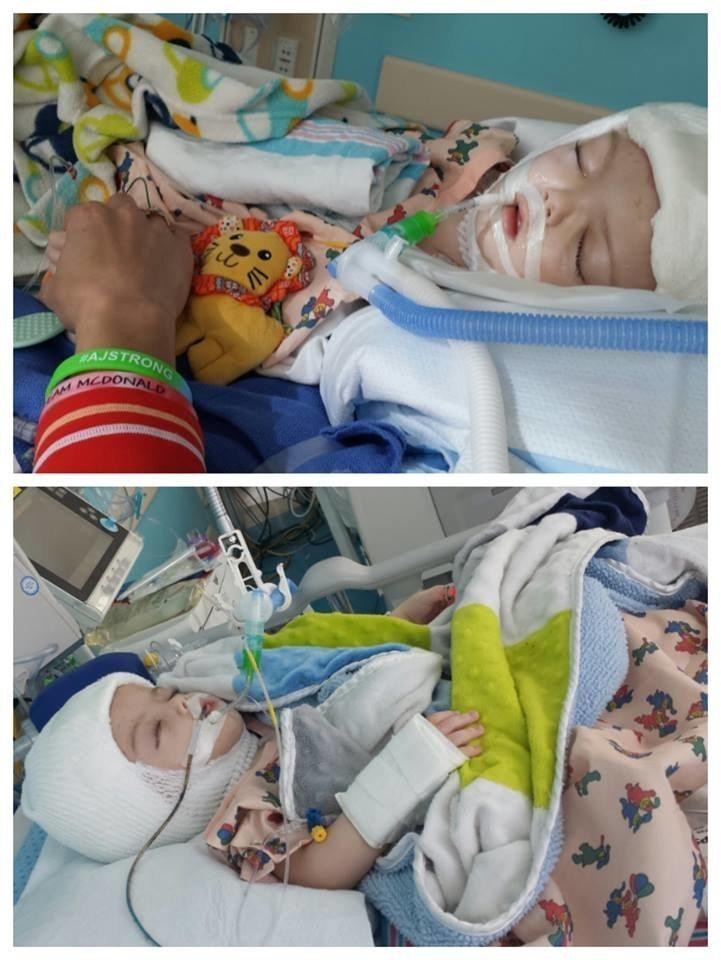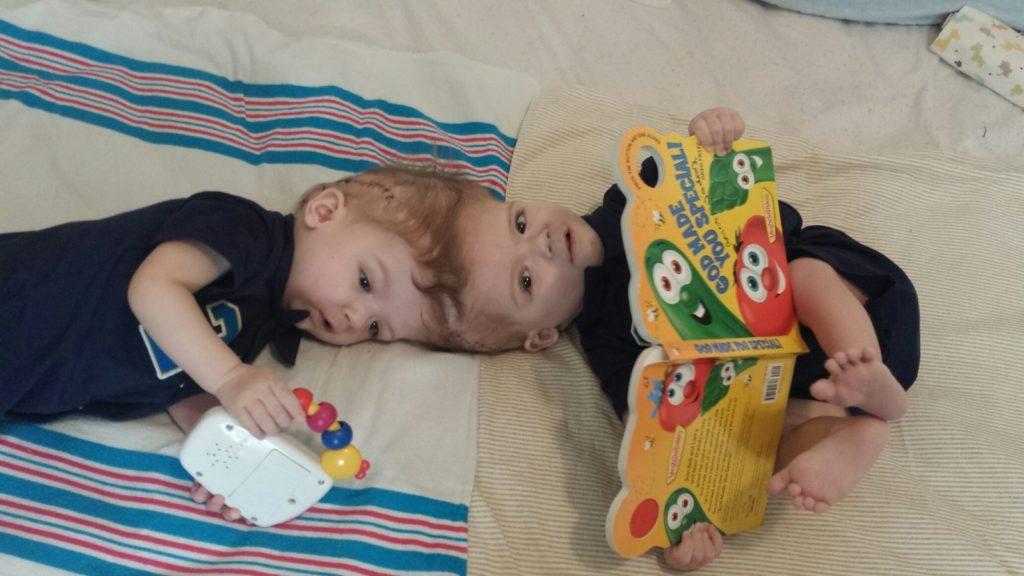Conjoined twins are extremely rare, and often don’t survive long past birth. The parents of those who do survive are faced with a choice: risk having the children separated in a surgery that could be fatal to one or both, or allow them to remain attached and face serious challenges in functioning throughout life? It’s become safer and easier to separate many types of conjoined twins than it used to be, but in some cases, depending on where the babies’ bodies are fused, it’s still incredibly difficult and dangerous.
In the case of craniopagus twins, who are joined at the head, the challenges are especially great. Craniopagus twins, if not separated, typically don’t live past their second birthdays, so surgically separating is a necessity – though an extremely dangerous one. Thirteen-month-old craniopagus twins Jadon and Anias McDonald presented a huge challenge to surgeons at the Children’s Hospital of Montefiore (CHAM), as their brains were connected in an extremely complex way.
“This was unexpectedly one of the hardest cases I have ever worked on,” said James T. Goodrich , M.D., Ph.D., D.Sci. (Hon.), director, Pediatric Neurosurgery, CHAM and professor, Clinical Neurological Surgery, Pediatrics and Plastic and Reconstructive Surgery, Albert Einstein College of Medicine. “We knew they shared an area of fused brain, but we did not know how complicated it would be until we looked inside.”
It was thanks to 3D technology that Dr. Goodrich and his team were able to look inside the boys’ brains before operating. Using a combination of 3D printed models and virtual planning software, the surgical team was able to carefully study the connected tissue and plan the course they would take to separate the babies. Even with the preparation, though, the process was far from simple; Jadon and Anias had to undergo four surgeries over the course of seven months before they were finally separated.
In the last decade, the standard procedure for the separation of craniopagus twins has been “staged separation,” or multiple surgeries. Prior to 2004, surgeons would attempt to separate the babies in one long surgery, which was very often fatal to one or both, until it was discovered that doing the procedure in multiple surgeries would allow the children’s veins and vascular systems to recover in the interim.
Dr. Goodrich is one of the leading surgeons in the separation of craniopagus twins; he performed the last such procedure at Montefiore in 2004, separating Carl and Clarence Aguirre, who recently turned 14. He has since consulted on 20 cases of craniopagus twins, and Jadon and Anias are the seventh set that Dr. Goodrich has successfully separated.
 On October 14, Jadon and Anias underwent their final procedure and are now recovering in their own individual hospital beds for the first time. After their brain separation, several hours of reconstructive surgery were required in which a team led by Dr. Oren Tepper, Director of the Craniofacial Surgery Program at Montefiore, rebuilt the children’s skulls with their own bone and covered them with skin that had gradually expanded between surgeries.
On October 14, Jadon and Anias underwent their final procedure and are now recovering in their own individual hospital beds for the first time. After their brain separation, several hours of reconstructive surgery were required in which a team led by Dr. Oren Tepper, Director of the Craniofacial Surgery Program at Montefiore, rebuilt the children’s skulls with their own bone and covered them with skin that had gradually expanded between surgeries.
“Once again the Montefiore Einstein team is leading the way in pioneering medicine that changes lives,” said Steven M. Safyer M.D., President and CEO, Montefiore. “This intricate procedure was greatly enhanced by cutting edge 3D technology that enabled the surgeons to see inside the boys’ brains. But what really makes this case so special to me is the way our entire community is embracing the McDonald family. This is Montefiore at its best: sophisticated science, medicine and patient care are at the heart and soul of what we do.”
The boys may eventually need additional surgeries, and they have a long way to go towards recovery. They will undergo rehabilitation therapy once they are strong enough, and will eventually go home with their mother Nicole, father Christian, and older brother Aza. The family, originally from Chicago, moved to the Bronx this year for the babies’ surgeries.
 Such a complex, risky procedure may have had a very different outcome without 3D technology, as in the case of so many other recently separated conjoined twins: Ximena and Scarlett Hernandez-Torres, joined at the pelvis; Knatalye Hope and Adeline Faith Mata, joined from the pelvis to the chest; a pair of twins connected at both the heart and liver; and more. In addition to Drs. Tepper and Goodrich, the team that worked on Jadon and Anias included Joaquim M. Farinhas, M.D., neuro-radiologist, Department of Radiology, Montefiore and Kamilah A. Dowling, D.N.P., nurse practitioner, Division of Pediatric Neurosurgery, CHAM. Discuss in the Conjoined Twins forum at 3DPB.com.
Such a complex, risky procedure may have had a very different outcome without 3D technology, as in the case of so many other recently separated conjoined twins: Ximena and Scarlett Hernandez-Torres, joined at the pelvis; Knatalye Hope and Adeline Faith Mata, joined from the pelvis to the chest; a pair of twins connected at both the heart and liver; and more. In addition to Drs. Tepper and Goodrich, the team that worked on Jadon and Anias included Joaquim M. Farinhas, M.D., neuro-radiologist, Department of Radiology, Montefiore and Kamilah A. Dowling, D.N.P., nurse practitioner, Division of Pediatric Neurosurgery, CHAM. Discuss in the Conjoined Twins forum at 3DPB.com.
Subscribe to Our Email Newsletter
Stay up-to-date on all the latest news from the 3D printing industry and receive information and offers from third party vendors.
You May Also Like
3D Printing Financials: Fathom Struggles in Financial Quicksand During Critical Transition
Facing a year of key transitions and financial pressures, Fathom (Nasdaq: FTHM) has filed its annual report for 2023 with the U.S. Securities and Exchange Commission (SEC). The document outlines...
Latest Earnings Overview for Australian 3D Printing Firms Titomic and AML3D
Australian 3D printing manufacturing firms Titomic (ASX: TTT) and AML3D (ASX: AL3) reported their financial results for the period from July to December 2023, marking the first half of their...
3D Printing Webinar and Event Roundup: April 7, 2024
Webinars and events in the 3D printing industry are picking back up this week! Sea-Air-Space is coming to Maryland, and SAE International is sponsoring a 3D Systems webinar about 3D...
3D Printing Financials: Unpacking Farsoon and BLT’s 2023 Performance
In the Chinese 3D printing industry, two companies, Farsoon (SHA: 688433) and Bright Laser Technologies, or BLT (SHA: 688333), have recently unveiled their full-year earnings for 2023. Farsoon reported increases...

































